
Kalanchoe, also written Kalanchöe or Kalanchoë, is a genus of about 125 species of tropical, succulent plants in the stonecrop family Crassulaceae, mainly native to Madagascar and tropical Africa. A Kalanchoe species was one of the first plants to be sent into space, sent on a resupply to the Soviet Salyut 1 space station in 1979. The majority of kalanchoes require around 6–8 hours of sunlight a day; a few cannot tolerate this, and survive with bright, indirect sunlight to bright shade.
Pachypodium bicolor is a species of plant in the family Apocynaceae.

Bryophyllum is a group of plant species of the family Crassulaceae native to Madagascar. It is a section or subgenus within the genus Kalanchoe, and was formerly placed at the level of genus. This section is notable for vegetatively growing small plantlets on the fringes of the leaves; these eventually drop off and root. These plantlets arise from mitosis of meristematic-type tissue in notches in the leaves.
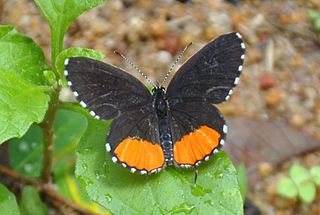
Talicada nyseus, the red Pierrot, is a small but striking butterfly found in the Indian subcontinent and South-East Asia belonging to the lycaenids, or blues family. The red Pierrots, often found perching on its larva host plant, Kalanchoe, are usually noticed due to their striking patterns and colors.

Kalanchoe daigremontiana, formerly known as Bryophyllum daigremontianum and commonly called mother of thousands, alligator plant or Mexican hat plant, is a succulent plant native to Madagascar. Like other members of Bryophyllum, it can propagate vegetatively from plantlets that develop on its leaf margins, as well as through upshoots from lateral roots, and seeds. All parts of this species contain a very toxic steroid known as daigremontianin.

Cotyledon orbiculata, commonly known as pig's ear or round-leafed navel-wort, is a South African succulent plant belonging to the genus Cotyledon.

Kalanchoe blossfeldiana is a commonly cultivated evergreen house plant of the genus Kalanchoe native to Madagascar. It is known by the English common names flaming Katy, Christmas kalanchoe, florist kalanchoe and Madagascar widow's-thrill.

Kalanchoe delagoensis, formerly known as Bryophyllum delagoense and commonly called mother of millions or chandelier plant, is a succulent plant native to Madagascar. Like other members of Bryophyllum, it is able to propagate vegetatively from plantlets that develop on its leaf margins.
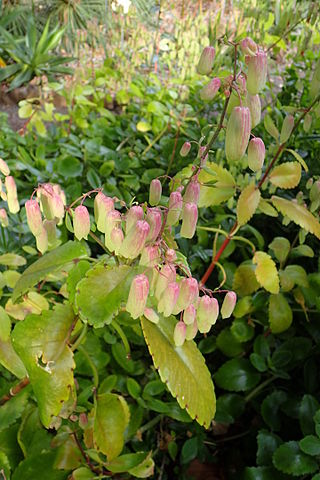
Kalanchoe pinnata, commonly known as cathedral bells, air plant, life plant, miracle leaf, Goethe plant, and love bush, is a succulent plant native to Madagascar. It is a popular houseplant and has become naturalized in tropical and subtropical areas. The species is distinctive for the profusion of miniature plantlets that form on the margins of its leaves, a trait it has in common with some other members of Bryophyllum.

Rubus repens(dewdrop, false violet, star violet, Robin runaway. French Canadian: dalibarde rampante) is a perennial plant in the rose family, native to eastern and central Canada and to the northeastern and north-central United States. It is part of the genus Rubus, which includes brambles, blackberries, and raspberries. Some authorities consider it the sole member of a separate genus, Dalibarda. It is fairly easily grown in shady locations in damp to wet, acidic soils, and is frequently used in wildflower and bog gardens as a ground-cover.
Ribes binominatum is a species of currant known by the common names trailing gooseberry and ground gooseberry.
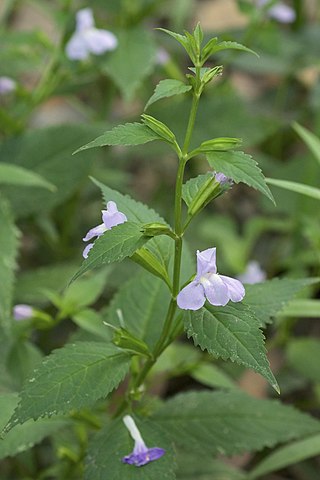
Mimulus alatus, the sharpwing monkeyflower, is an herbaceous eudicot perennial that has no floral scent. It is native to North America and its blooming season is from June to September. The flowering plant has green foliage and blue to violet flowers. It has a short life span compared to most other plants and a rapid growth rate. Like other monkey-flowers of the genus Mimulus, M. alatus grows best in wet to moist conditions and has a bilabiate corolla, meaning it is two-lipped. The arrangement of the upper and lower lip petals suggests a monkey’s face. The winged stems together with the monkey face give the plant its common name.

Kalanchoe millotii is a succulent plant that is native south-central and southeastern Madagascar. It forms a shrub up to a foot high. The leaf is a hazy green and scalloped, with dense felt covering it.

Kalanchoe manginii, beach bells, is a species of flowering plant in the family Crassulaceae, native to Madagascar. It is an evergreen succulent perennial growing to 30 cm (12 in) tall and wide, with arching branches of rounded, glossy leaves, and urn-shaped salmon-red flowers in spring. As the minimum temperature for growth is 10 °C (50 °F), in temperate regions this plant must be grown under glass as a houseplant.

Holmgrenanthe petrophila is a rare perennial desert plant in the plantain family (Plantaginaceae), and the sole species of the genus Holmgrenanthe. It forms low mats of branched stems growing from a woody base. The leaves have small spines along their edges. The solitary yellow flowers are tubular with five free lobes at the end, the upper two pointing backwards, the lower three projecting forwards. The species is known only from about ten locations, most in the Titus Canyon and the adjacent Fall Canyon, all within the Californian section of Death Valley National Park. It grows in limestone crevices on the canyon walls, often on the north face.

Kalanchoe longiflora, also known as tugela cliff-kalanchoe or long-flower kalanchoe, is a species of the succulent genus Kalanchoe, in the family Crassulaceae. An obscure shrub native to South Africa, it is known for its multi-coloured foliage and yellow flowers, which bloom in autumn to winter.

Kalanchoe × poincarei is a species of Kalanchoe native to southern Madagascar. Its scientific name is often misapplied to K. suarezensis and K. mortagei, but K. × poincarei is very different from them. The true K. × poincarei is a natural hybrid involving K. beauverdii, with similar sprawling stems up to 3 m in length, and not known in cultivation, whereas K. suarezensis and K. mortagei are erect, 30~60 cm tall and cultivated as ornamentals.
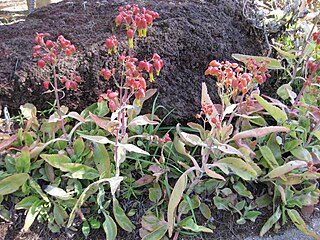
Kalanchoe suarezensis is a species of Kalanchoe native to northern Madagascar.
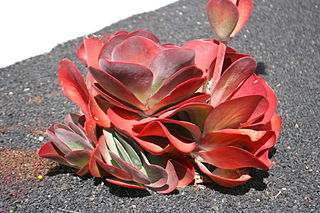
Kalanchoe luciae, the paddle plant or flapjacks, is a species of flowering plant in the genus Kalanchoe, native to northeast South Africa, Eswatini, Mozambique and Zimbabwe. It has gained the Royal Horticultural Society's Award of Garden Merit.

















